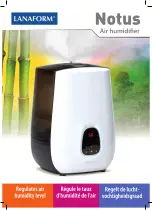
13
c. Algae or slime can usually be controlled by means
of an intermittent or batch treatment to shock the
organisms. Chemicals used for this treatment are
chlorine, bromine, pentachlorphenate, copper-
sulphate, or potassium permangenate. Some of
these, however, may promote corrosion if used in
excessive quantities or if not properly controlled.
d. Conductivity Galvanic Corrosion
CAUTlON:
Water treatment should be undertaken
only by those who are qualified and competent to
prescribe what is required for each individual
problem. Beware of secret compounds and
guarantee’s that claim (to render) obviously
improbable results.
NOTE:
In consideration of the above, it should be
apparent to the user that the manufacturer cannot
accept responsibility for inefficient operation or
corrosion of the condenser when caused by
foreign materials or failure to use adequate water
treatment. Again, necessary water treatment
should be initiated at, or before, the time of
installation since deterioration, when once started,
is extremely difficult to stop.
C. Water-cooled Refrigerant Condenser Cleaning
1. The following procedures and precautions should be
observed when cleaning is undertaken. The warranty
on the condenser is void if it is damaged by improper
methods or tools.
The condenser heads (end plates) are removable on all
models. For reference, the “water head” is the end
plate to which all condenser water piping is connected
and the “return head” is the end plate on the oppo-
site end of the condenser.
2. Chemical Cleaning - the condenser manufacturer
does not recommend any particular chemical prepara-
tion. The same treatment is not applicable to all
installations. See MAINTENANCE WATER COOLED
REFRIGERANT CONDENSER (Section 4.2.B.3) for general
information on water treatment.
In any case:
(a) Use only preparations from an established, reliable
source.
(b) Follow directions exactly- particularly regarding
amounts to use, and flushing or neutralizing
procedure after cleaning.
3. Mechanical Cleaning
a. Before disassembly of the condenser for mechani-
cal cleaning, the following must be performed:
(1) Stop operation of the refrigeration system. The
refrigerant does not need to be pumped out of
the condenser.
(2) Stop operation of the water circulating pump
and the cooling tower, if applicable.
h. Partly closed compressor discharge valve: Check to
see that it is fully open.
2. Low or high water temperatures at the condenser
outlet-The condenser is regulated by a pressure
actuated water regulating valve supplied by the
factory. In normal operation, the temperature differ-
ence between the water temperature leaving the
condenser and the refrigerant condensing tempera-
ture [saturation temperature, from refrigerant table,
corresponding to discharge (head) pressure] will be
between 5
°
F/9
°
C and 12
°
F/22
°
C. This normal tempera-
ture difference occurs regardless of the water tem-
perature entering the condenser.
If a low water temperature (more than 12
°
F/22
°
C
below the refrigerant saturated condensing tempera-
ture) is experienced, cleaning is indicated. Good heat
exchange is not being accomplished because of water
tube fouling.
If a high water temperature at the outlet is experi-
enced, something other than a fouled condenser may
be causing improper system operation and/or high
discharge (head) pressures. Restricted water flow, or a
low water supply pressure, is indicated. A restriction
can occur with foreign matter in the condenser, but it
is also likely to be somewhere in the water system.
3. Water Treatment
The long range performance of the refrigerant
condenser will be adversely affected by poor water
conditions. Therefore, it is recommended that an
analysis of the condenser water be made and treat-
ment, if required, commenced prior to operating the
refrigeration system.
Chemical additives, including those to stop algae and
related growths, should be obtained only from a
reputable, established supplier, and used specifically
according to directions. Excessive or incorrect treat-
ment of the water can cause more harm than none at
all; the pump, piping and cooling tower may be
damaged as well as the condenser.
For general information, the three major problems
which the water treatment must cope with are: (1)
scaling of the condenser surfaces, (2) corrosion and (3)
algae or slime.
a. Scale control is usually undertaken with phosphate
compounds. Scale is most often encountered
when the ph of the water is high or on the alkaline
side.
b. Corrosion is generally the result of low ph, or on
the acidic side. Among the chemicals used for
corrosion control are glassy phosphates,
chromates, and nitrates. Chromates are poisonous
and must be handled carefully.
If the ph of the water is maintained between six
and eight, there will be the minimum tendency
toward scale on the high (above 8.0 ph) side and
corrosion on the low (below 6.0) side.
Summary of Contents for RHC Series
Page 9: ...9 Typical Wiring Schematic...






































